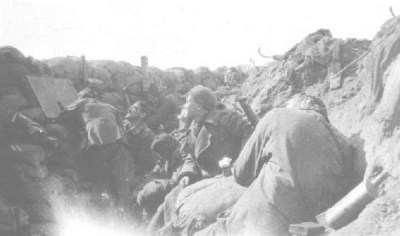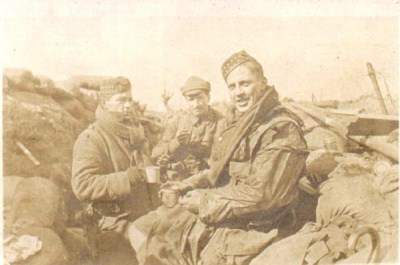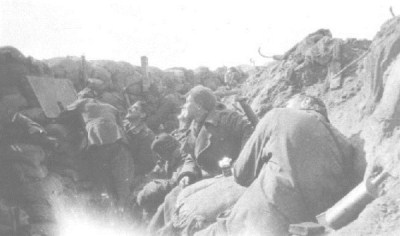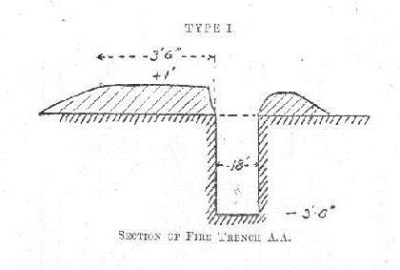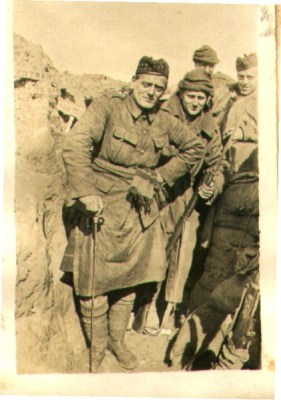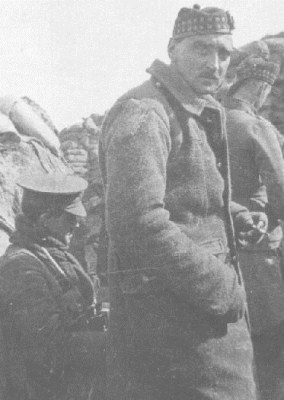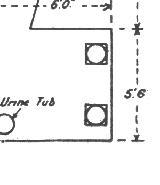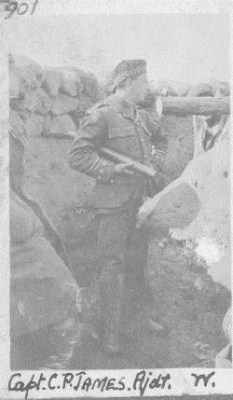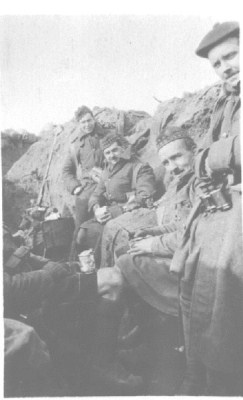Early Spring 1915
Action in the Trenches
Routine and Sickness
 The normal routine was three days in the trenches, xxxx days in the reserve trenches and xxx days out of line (but this often involved moving up to the line at night to form working parties for wiring or carrying parties for stores).
The normal routine was three days in the trenches, xxxx days in the reserve trenches and xxx days out of line (but this often involved moving up to the line at night to form working parties for wiring or carrying parties for stores).
Wrapped Up Well against the Cold Visit Captain AS Anderson in the front line. Look at the evidence of trench life in a photo he wasn't expecting.
The Liverpool Scottish entered the front line at the end of November 1914, with 855 soldiers. By the end of January 1915 following terrible winter weather the total strength had fallen to 370. Almost all of the decrease was caused by men falling sick; in that period there were only about 30 killed or wounded. When the first draft of reinforcements arrived from England, they virtually doubled the active strength of the battalion.
The Home Front
Christmas 1914 and Support from Home Christmas was spent out of the line when 'the mails were colossal' (250 sacks amongst less than 1000 men), a gift from Lord Derby of 'plum puddings for the men ... and a full Christmas dinner for the officers'. It is clear that the support from home for the Liverpool Scottish in Belgium was very significant. There were many supporters back in Liverpool and the Wirral to provide that which the Army could not or would not make available.
Christmas 1914 - The Regimental History - Colonel McGilchrist
".. Ladies' Committee ... worked indefatigably at the knitting and collecting of socks, cap comforters and cardigans ... "
Mr John Rankin gave £60 a month to provide extra rations for the men .... he combed England from one end to the other to provided the number [of Primus stoves] required"
"... a particular drug he [Lt NG Chavasse, the battalion's MO] required ... was ordered by cable from the United States and reached him [Chavasse] in a fortnight".
Home comforts find their way to the front
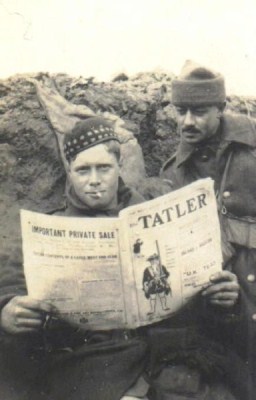 Daily newspapers could reach the front in Belgium on the day they were published in London.
Daily newspapers could reach the front in Belgium on the day they were published in London.
Cardigans - A knitted woollen jacket normally buttoning at the front (as opposed to a 'pullover' which is pulled over the head. Its invention is attributed to Lord Cardigan, commander of the Light Brigade in the Crimean War of 1854/55. By January 1915, soldiers were receiving goatskin jackets which were a great improvement but still left men cold and wet.
Primus stoves - This recognises the the need for being able to heat food in the trenches where it was often not possible to bring up rations during the day and only with the greatest difficulty at night. Braziers came into common use during January in the front line.
Efforts of the Battalion to helps itself
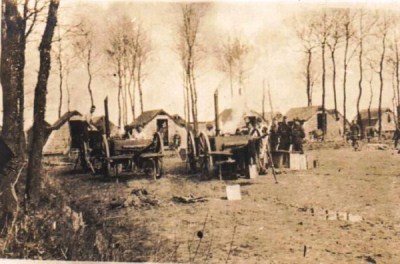 The battalion cookers are seen in action, probably in a rest camp out of the line in the Ypres Salient, possibly at Dickebusch. Regimental history makes very clear that the 'self-help' efforts of the battalion through the legitimate (and sometimes less-than-legitimate i.e. 'dodgy') initiative of individuals in key positions together with direct support from home (gifts and money) contributed enormously to the welfare (i.e comfort) and survival of the Liverpool Scottish through what was a very hard winter. The battalion's cooking arrangements are seen to the right with mobile cookers in position. When the battalion was in the line, food would often be cooked in a rear area and then carried forward through the trench system to arrive cold in the front line.
The battalion cookers are seen in action, probably in a rest camp out of the line in the Ypres Salient, possibly at Dickebusch. Regimental history makes very clear that the 'self-help' efforts of the battalion through the legitimate (and sometimes less-than-legitimate i.e. 'dodgy') initiative of individuals in key positions together with direct support from home (gifts and money) contributed enormously to the welfare (i.e comfort) and survival of the Liverpool Scottish through what was a very hard winter. The battalion's cooking arrangements are seen to the right with mobile cookers in position. When the battalion was in the line, food would often be cooked in a rear area and then carried forward through the trench system to arrive cold in the front line.
'self-help' efforts
- The Quartermaster's staff claimed to have been the first to divide rations into packs for so many men (in sandbags) to be distributed quickly at night at the forward dump.
- Somebody 'found' a sausage-making machine, presumably when it fell off the back of a passing lorry. This was reportedly a 'first' for any battalion in the BEF.
- Company Quartermaster Sergeant RA Scott McFie of Y Company published his own cook book 'Things That Every Good Cook Should Know'. In civilian life he was a fine scholar and a member of a prominent business family. The Museum holds some of his meticulously kept note books.
Lt (later Captain) Noel Chavasse, later to win two Victoria Crosses, was the battalion's medical officer (MO) from going overseas in 1914 until his death in August 1917.He made great efforts to maintain the health and morale of men in the line through a wide range of methods.
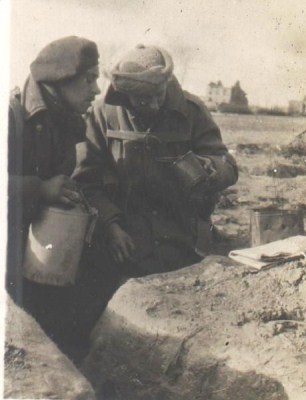 Cardigans - A knitted woollen jacket normally buttoning at the front (as opposed to a 'pullover' which is pulled over the head. Its invention is attributed to Lord Cardigan, commander of the Light Brigade in the Crimean War of 1854/55. By January 1915, soldiers were receiving goatskin jackets which were a great improvement but still left men cold and wet.
Cardigans - A knitted woollen jacket normally buttoning at the front (as opposed to a 'pullover' which is pulled over the head. Its invention is attributed to Lord Cardigan, commander of the Light Brigade in the Crimean War of 1854/55. By January 1915, soldiers were receiving goatskin jackets which were a great improvement but still left men cold and wet.
Primus stoves - This recognises the The need for being able to heat food in the trenches where it was often not possible to bring up rations during the day and only with the greatest difficulty at night. Braziers came into common use during January in the front line. We can see a brazier in use in the photo on the right. the brazier is simply a can with holes punched in it and can be see on the right of the picture.
Diary of Sgt DAB Marples: later Regimental Sergeant Major and was awarded the Military Cross as a Company Sergeant Major
Feb 26th 1915 "A glorious sunny day after a hard frosty night. Teague, another of my cheeriest boys in the platoon was shot in the head at noon whilst right beside me. A wretched day for my platoon, being peppered with enemy rifle fire from 20 yards away; sand bags being ripped away all day".
Sand bags (generally filled with earth) solidified the structure of the trenches and (although much larger) could be laid like bricks within headers and stretchers to give a bonded strength. In this case the enemy fire seems to be aiming to break down the strength of the sandbags and leave the occupants of the trench in greater danger.
Mar 5th 1915 "A fine day. Had a two hour march and parade in the forenoon and got leave with Sgt. Finnie to go to Poperinghe in the afternoon. Had a pleasant afternoon and a good English meal of steak and chips".
Poperinghe was a small Belgian town just behind the front line area which was relatively safe. It provided rest and recuperation facilities for tired Tommies at a variety of restaurants, cafes, estaminets and also, for much of the war, at the famous Talbot House run by the Rev. Tubby Clayton. However, the town of Ypres/Ieper remained in full swing through to spring 1915 although actually under fairly continual shellfire and about two miles from the front line.
Mar 9th 1915 "A fine day but very cold. Severe frost last night. Had a glorious bath and issue of clean underclothing and kilts stoved free from lice"
"kilts stoved free from lice" = Lice developed very quickly in the trenches and were a great source of discomfort to soldiers.
Link to each page by clicking the images below.
Previous page: Winter 1914
Next page: The CO and the grenade
